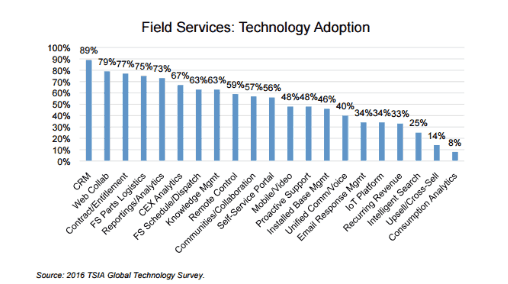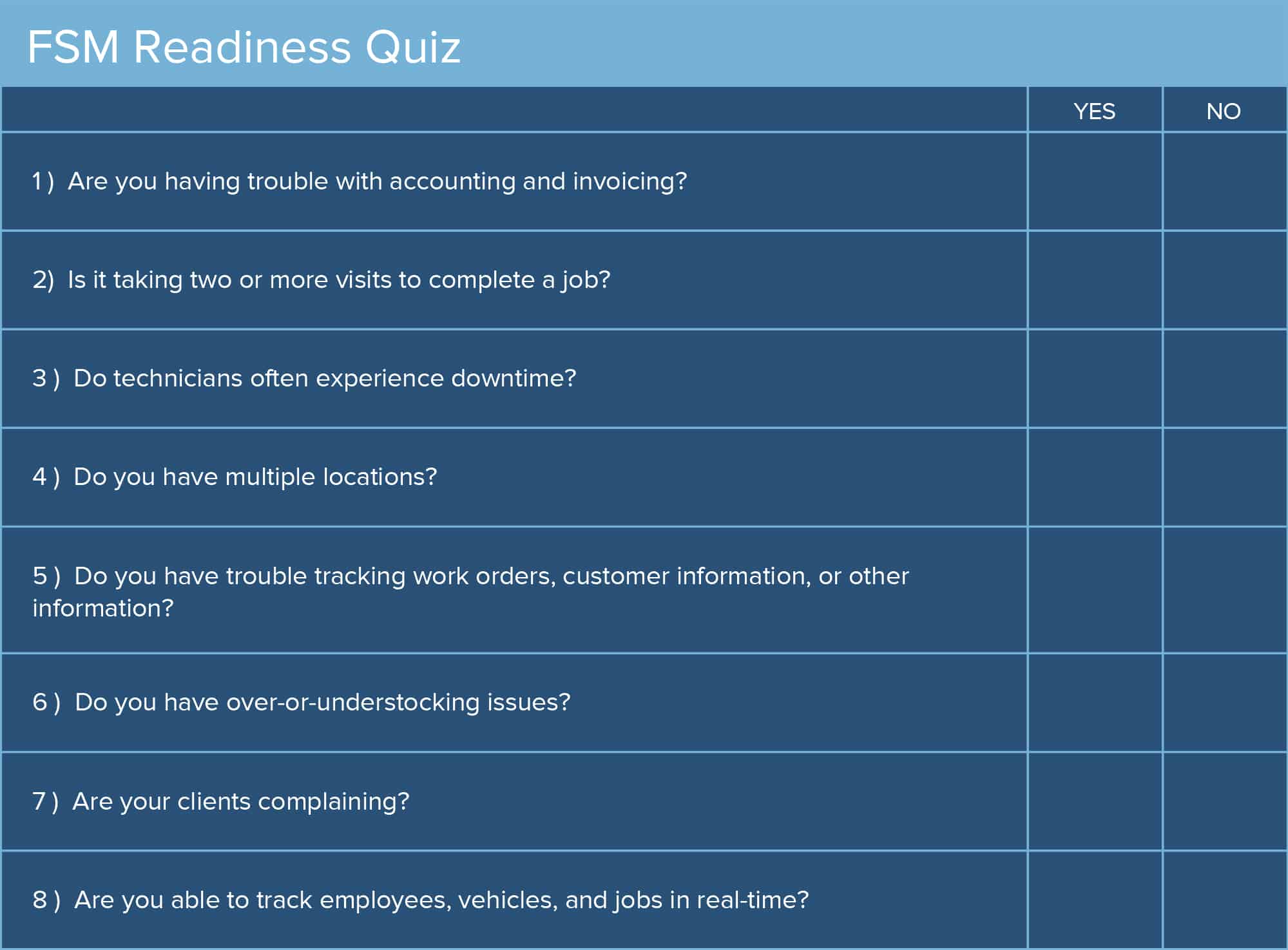What are Field Service Management Software and Apps?
The term Field Service Management (FSM) encompasses both the activity and the software that enables companies to manage off-site workers and resources. It is prevalent in industries with mobile workers, utilities, telecommunications, healthcare, and waste management. FSM supports activities like scheduling, tech dispatch, vehicle location tracking, and job status required to perform tasks effectively and efficiently. It can also foster greater customer satisfaction with real-time customer communication, on-site information about products and repair issues, and more timely service and issue resolution.
Deployment Options
- On-Premises: On-premises solutions installed and hosted in-house are managed by internal IT staff and usually cost more up-front. Though there aren’t incremental ownership costs, this option does incur regular service and maintenance expenses. Data security is in the hands of the organization, and in some cases, may be a key driver for using this option. Internal IT teams sometimes have difficulty managing existing on-premises solutions to support new applications, integrations, and updates.
- Cloud-Based Software: Software-as-a-Service (SaaS) is maintained and managed by an external provider via the internet. The SaaS delivery model is rapidly gaining traction in FSM because it has lower upfront expenditure, is faster to deploy, and offers the agility to scale up or down as company needs change. Regular scheduled maintenance and software upgrades comes with little to no end-user involvement.
- Mobile Apps: Cloud systems offer native mobile apps for some or all three device platforms: iOS, Android, and Windows for greater accessibility. This easier access also means there are some security considerations, particularly if field service techs access company data and files on personal mobile devices.
To learn more, check out our industry review All About Field Service Management.
Benefits of Field Service Management Software and Apps
Beyond opening up the lines of communication, field service software and apps enable efficient scheduling and inventory tracking, and easier administration and prompt work invoicing. And, when used in suites, everything synergistically works together . Deploying FSM tools leads to one thing: the customer loyalty that excellent service engenders. Some of the key benefits you can gain by using the FSM software and apps include:
- Customer satisfaction and retention - In a consumer-oriented world where opinions about companies can be shared instantaneously -- and have a disproportionate impact on business -- organizations that provide field service focus on delivering the timely and seamless interactions that breed customer brand loyalty. Forrester analyst Kate Leggett said that according to her 2016 trend research, “73% of consumers say that valuing their time is the most important thing a company can do to provide them with good service — whether on a call, in a chat, or while waiting for a service technician to troubleshoot and fix their product.”
As Coates noted in her book on field service best practices, “Your ability to deliver superior field service, to quickly and effectively fix any issues that arise, will result in high customer satisfaction and lead to increased customer loyalty.”
- Field worker satisfaction - Service dispatch and field service scheduling software can help create a mobile workforce who appreciate the seamless assignment from one job to the next. Making things on the job easier creates a less stressful work environment for technicians and can help exceed customer expectations through faster and higher quality service. Oracle’s The New Rules of Field Service Management found that after integrating a field service management solution, companies saw a “15 percent increase in overall productivity of the field force, a 15 percent reduction in the number of people needed in the field, a 98 percent one-time arrival, and a 75 percent reduction—if not outright elimination—of overtime.”
- Multiple efficiencies - Revenue can be lost without a good system for tracking invoices and payments. Worst of all, if you don’t have an efficient scheduling system or customer relationship management (CRM) system that stores contact info and service history, your all-important customer relationships can suffer. Field service management technologies also boost efficiency in handling much of the administrative and scheduling tasks to ensure operations run smoothly. In addition to off-site personnel management, FSM software and apps manage the tools, spare parts, and equipment required for maintenance, as well as the interaction between technicians and customers. The Oracle white paper previously quoted said that companies using a field service management solution for their mobile workforce have reported a 40 percent decrease in distance driven per appointment, a 75 percent reduction in overtime, and a 47 percent increase in the rate of jobs completed each day. Companies can save an average of $5,000 to $20,000 per field service employee per year.
- Cost-savings and first-time fix rates -There are many ways that FSM software and apps lower the cost of doing business. “Most companies now recognize that there are big margins to be made in services,” said Coates. “While companies may be experiencing downward price pressure on products, field service still looms large as a high-potential area for major profitability and customer loyalty.”
A good example of how proper implementation of FSM can save money is first-time fix rate. First-time fix rate is the percentage of jobs that are resolved the first time a field technician visits and is one of the key performance metrics for field service organizations, or it should be. In Aberdeen Group’s Field Service 2013: Workforce Management Guide, 17 percent of the service organizations surveyed don’t measure first-time fix rate, or were not aware of theirs. Despite this extremely low number, Aberdeen noted that the complaint of 57 percent of respondents was that their technician could not resolve the issue. First-time fix rate improves customer service ratings and directly impacts all levels of field service, from revenue, to cost, to productivity and efficiency levels. You can increase first-time fix rates by consolidating critical job tools—schematics, diagnostics, and manuals—and making them available anytime, anywhere with FSM software and apps.
The Mobile Field Service Management Software and App Market Revolution
TSIAs 2016 Technology Adoption and Spending Report: Field Service, an annual global survey of its members (the organization has over 250 corporate members and 30,000 individual members) shows the growing proportion of different types of software being used today. The levels of technology adoption that are being driven by the widespread adoption of digital mobile devices now form an integral part of both work and personal lives. The proliferation of tablets driven by the introduction of the iPad in 2010 has contributed to the ongoing adoption of using mobile devices (some more rugged than others) in the field. This use may be a mix of smartphones, tablets, and laptops, but as such the focus of the service work has moved significantly from on-premises, server based software to include the field technician.
“In the industrial products and electronic equipment world, fast and effective service is dependent on uptime,” Coates explained. “In a wired world, it simply makes sense to use every technology you can to build your brand and beat the competition.” There are many reasons to employ FSM software, apps, and other technologies:
- Seamless workflow - Back office processes are at the heart of any service operation. Mobility solutions provide the entire organization with the ability to seamlessly manage workflow and keep all operational elements connected. You can also see the work and performance for the day. Whether a complex, fully optimized and automated scheduling system is needed or a manual drag-and-drop solution is employed, mobile access allows decisions to be based on real-time activity and updates.
- Technicians as a priority in field service - In a 2015 report Evolution of the Field Service Business – Optimising the Service Supply Chain by the Aberdeen Group, leading field service organizations said their top strategy for growth is to invest in mobile tools to provide service workers with better access to information. Offering access to real-time data in the field via mobile tools empowers the service team to deliver the right answers at the time of service, ultimately providing greater levels of customer service and resolution on a first visit.
- Customer intelligence gathering via field workers - In field service, the impact of mobility is significant, especially on the front lines where technicians now have access to information that can improve productivity and customer results. Regional managers and service leaders are looking for better decision-making tools via their mobile devices while customers also want better access to self-service information via mobile applications and tools. “Techs who actually are in front of the customers, day-in and day-out know more than customer service office personnel and are an untapped resource every company should take advantage of,” advises Coates.
FSM Market Outlook
Despite the benefits and growing adoption, the Salesforce Service Excellence Survey 2016 found that 54 percent of the companies surveyed are using manual methods to handle field service and 77 percent still use an on-premises field service solution. This means that there is a huge market opportunity. According to a 2015 report from MarketsandMarkets, “The Global Field Service Management Market [is expected] to grow from $1.58 billion in 2014 to $3.52 billion by 2019, at a Compound Annual Growth Rate (CAGR) of 17.3%. North America is expected to be the largest market in terms of market size, while Europe and Asia-Pacific are expected to experience an increase in market traction during the forecast period.”
Much of the growth that Field Service Management is experiencing can be attributed to the increasing ubiquity of mobility. In the current market and going forward, mobility isn’t just a way to replace paper-based processes, but is seen as an extension of organizations with field service as a customer service and customer management strategy.
4 Steps to Making the Right FSM Decision
How do you begin the software decision making process for your organization? We’ve lined up some information, questions to ask yourself, a software features checklist, and some resources to help you make an informed decision. Let’s get started.
1. What Type of User Are You?
An important consideration when choosing the type of software to manage your field service operations is the size of your business, and whether or not you rely on outside contractors to fulfill your service requirements.
- Large Enterprises need integration capabilities - A field service management system that integrates with existing ERP or CRM systems is critical, since data captured in the field should be available across all business units.
- Small-to-Medium businesses (SMB) need scalability. Growing SMBs with off-site employees can benefit from automated processes and tools to efficiently manage field workers, and increase productivity and visibility. Though smaller companies may only initially need dispatch software or fleet management, cloud-based solutions offer scalability and robust functionality at an affordable price.
- Third-Party services should provide visibility. If you employ third-party contractors or outside contractors to reduce labor costs and expand operations, client details and visibility are as important as functionality. You need to know when a service is delivered, how long it took, or if the issue was quickly resolved. You should look for visibility through third-party vendor portals used to manage contracted work and related administrative tasks.
2. Am I Ready to Use FSM Software or Apps?
Any field service system that can make a real difference to your business requires an investment of time -- and more than likely -- money. A good way to move your process forward is to form a team with members from multiple departments to determine what your organization needs. Once you have a good understanding of requirements, document and communicate the business case for your new system and the improvements you expect to achieve. Having an overview of your needs is an important step to justify your investment. If you decide to buy FSM software or a suite of products, this information will help vendors steer you toward a solution that’s right for your company.
Here are some questions to discuss with your team to help determine whether your company needs to invest time and money in FSM software or apps.
If you have more ‘yes’ answers than ‘no’ you’re probably ready to investigate in FSM technology solutions.
3. Understanding the Difference Between Open Source, Freemium, and Paid FSM Software
To pay, or not to pay? That question can be answered based on your self-evaluation and how many bells and whistles you need to run your own field service organization and meet customer needs. “Something to think about is that free software versions tend to be standalone and not integrated,”observes Coates. “As the software and market have matured, best-in-class software offers integrated systems. But just about every kind of software now gives you a free, trial option so you can try before you buy.”
When it comes to affordability, functionality, and overall integration, there are three general categories to consider:
- Open source FSM - While there are hundreds of software and app options for FSM, open source is more limited. Since open source solutions are free, they can have limitations, but the non-existent price point may make it easier to overlook shortcomings. The limitations also may not be off-putting for smaller businesses. Of course, there is usually no support beyond a community-based wiki.
- Freemium - There is a spot between open source and fully paid software and apps called freemium. These are free versions of FSM software, but those usually come with a mandatory email list sign-up. If you need to have more than one version, proprietary features, or additional functionality, you’ll need to pay a monthly charge for additional users and the more premium product.
- Paid - Most FSM solutions charge a fee-for-service and the price depends on multiple considerations: organization size, business requirements, user number, carrier selection, and projected data usage. It’s not uncommon for there to be other fees for the use of the platform like extra technical support or training.
Coates weighed in on the free versus paid question, “I think that at any size of business, thinking about integrating every part of your business with software just makes sense today. So does having mobile capability to do everything from order taking to check out, and making sure that is tied into every activity. It’s what customers expect. And when you pay for software, you end up saving time with the professional support that’s provided.”
4. What FSM Software and App Features Should You Look For?
While every field service process begins with a service request and ends with an invoice, there are many things that happen in between. Automating the process, no matter what size your business may be, can help lower the cost of service delivery, give you an edge over competitors, and help you provide a tailored experience that will keep your customers satisfied.
Field Service Management Software and App Research Resources
Once you’ve taken a look at the kind of software you may want to acquire based on your business type, specific requirements, and product features, it’s a good idea to do some research. Here are some ways to get additional information to help you make a final decision:
Search Engines: Business software comparison search engines offer apples-to-apples and in-depth reviews. Some of the sites also include open source software in their reviews.
Professional Organization and Associations: These field service organizations provide resources and peer support. Some information is only available through membership, while some groups only require form completion to download gated research.
- National Association of Service Managers (NASM) promotes education and training in the service and support profession with a consistent commitment to the advancement of service managers in all vertical industries.
- Reverse Logistics Association (RLA) was founded in 2002 for third-party service providers who offered reverse logistics services, and the OEMs, retailers, and brand marketers who needed their services.
- The Service Council focuses on building and supporting a platform for education, knowledge, networking, and insight for the community of business executives overseeing functions of service and customer management.
- Technology Services Industry Association (TSIA) (formerly AFSMI: Association for Services Management International) member community includes a diverse set of technology companies of all sizes. In 2016, TSIA had 30,000 individual members.
Using KPIs to Manage Field Service
A consideration in FSM software selection is collecting data and measuring it against KPIs. Some common KPIs for field service organizations are equipment uptime, first-time fix, and service response time. “To improve customer satisfaction and loyalty,” said Coates, “you must generate customer-centric KPIs and measure what customers think is important to their business, not what you think.”
Smartsheet for Field Service Management
Empower your people to go above and beyond with a flexible platform designed to match the needs of your team — and adapt as those needs change.
The Smartsheet platform makes it easy to plan, capture, manage, and report on work from anywhere, helping your team be more effective and get more done. Report on key metrics and get real-time visibility into work as it happens with roll-up reports, dashboards, and automated workflows built to keep your team connected and informed.
When teams have clarity into the work getting done, there’s no telling how much more they can accomplish in the same amount of time. Try Smartsheet for free, today.



